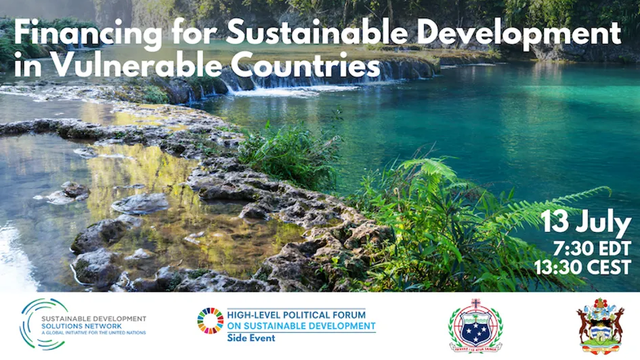Financing for Sustainable Development in Vulnerable Countries
“Time for action on SDG financing is now”, highlighted several government and UN officials, as well as representatives from international organizations and Multilateral Development Banks during the webinar “Financing for Sustainable Development in Vulnerable Countries”, an official side-event at the High-Level Political Forum 2022.
Progress on sustainable development is at risk globally, jeopardized by over two years of the COVID-19 pandemic and multiple international crises. The 2022 Sustainable Development Report prepared by the UN Sustainable Development Solutions Network (SDSN) reveals that for the second year in a row, the world is no longer making progress on the Sustainable Development Goals (SDGs). Achieving the SDGs requires significant investments on human capital, physical infrastructure, and environmental protection.
Several countries – including Small Island Developing States (SIDS) and least developed countries – still struggle to mobilize the financing needed to make progress on the SDGs. SIDS are the most vulnerable countries in the world as they are the first victims of climate change and face several other structural barriers to development, including their small size and remoteness. While these countries require massive financing for disaster recovery and resilience building, they only have limited domestic resources. Their fiscal space is narrow because of their small tax base; they generally suffer from heavy debt burdens because of their high exposure to risk; and they are left with sizeable SDG financing gaps, as they do not meet the current criteria to access concessional finance.
With the objective to discuss the issue of financing to achieve the SDGs in vulnerable states, the SDSN co-organized with the SIDS Resident Coordinators Network, the Government of Antigua and Barbuda, and the Government of Samoa, a High-Level Political Forum (HLPF) official side-event on 13 July 2022. The three keynote speakers– Prof. Jeffrey D. Sachs (SDSN), H.E. E.P. E. Paul Chet Greene (Antigua and Barbuda), and H.E. Ambassador Fatumanava-o-Upolu III Pa’olelei Luteru (Samoa) – all agreed on the urgent need to redesign the global development financing system. They highlighted that closing the SDG financing gap by 2030 globally is only possible if we strengthen international solidarity and facilitate vulnerable countries’ access to financing. The resources needed to finance the SDGs are significant at the national level but only represent a small share of the world’s total output.
The event gathered government and UN officials, representatives from Multilateral Development Banks (MDBs), the Organization for Economic Cooperation and Development (OECD) and other international organizations, as well as civil society and academia, who shared their views on how to measure and address the SDG financing gap in vulnerable countries. Two panel discussions focused on i) Measuring the SDG financing gap in vulnerable countries, and ii) Financing the SDGs: lessons learned and ways-forward.
The participants of the first panel– moderated by Dr. Isabella Massa (SDSN) – reminded that different methods exist to estimate the SDG financing gap, from top-down macro estimates to bottom-up approaches relying on the cost of individual inputs required to achieve specific SDG targets by sector. They mentioned that further work is needed to expand the estimates of the SDG financing gap to include climate change mitigation and resilience targets. The panelists insisted on the significant vulnerability of SIDS to climate change, highlighting that, each year, these countries lose around 2% of their GDP because of natural disasters.
In the second panel– moderated by Mr. Didier Trebucq (UN Resident Coordinator) – the participants provided advice on how governments and financial institutions can reshape the current financial system to allow the use of more flexible mechanisms to finance the SDGs in vulnerable countries. They raised the issue of debt overburden as a barrier to unlock sustainable development and growth, and suggested that a clear engagement of local stakeholders, including national Public Development Banks and the private sector, is key to mobilize financing for the SDGs. While traditional sources of financing such as tax revenues will remain essential to finance the SDGs, the panelists also argued that it is essential to increase their untapped potential (e.g. by improving tax administration) and explore emerging opportunities such as the use of green bonds.
Dr. Simona Marinescu, UN Resident Coordinator in Samoa, presented the findings of the joint work conducted by the SIDS Resident Coordinators Network in partnership with SDSN to measure SIDS multidimensional vulnerabilities and assess their SDG financing gap in line with General Assembly resolution A/RES/76/203.
SDSN and UN Resident Coordinators will pursue their collaboration on the estimation of SIDS’ SDG financing gap. This event provided valuable inputs to inform the next steps of this joint project that aims at estimating SIDS’ financing needs on each of the 17 SDGs, identifying relevant targeted financing mechanisms, and developing an efficient Multidimensional Vulnerability Index (MVI) to unlock vulnerable countries’ access to concessional finance.
